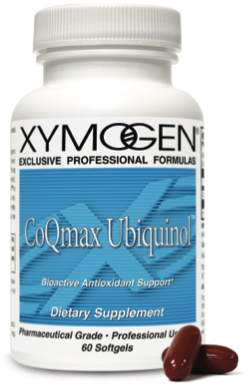CoEnzymeQ10 (CoQ10)

Supplementation may help maintain normal levels of ubiquinol in the body as well as address drug-induced nutrient depletion of CoQ10. Until recently, the ubiquinol form had not been effective as a supplement because it was chemically unstable and easily oxidized.
Antioxidant Status Oxidative stress is detrimental to the integrity and function of cell membranes and tissues, and ultimately to DNA itself. Antioxidant status must be maintained throughout the body in order to protect vulnerable cells. Research indicates that CoQ10 supports antioxidant activity, including the regeneration of vitamins C and E, helping to maintain normal levels of free radical activity in the body. Researchers also suggest a possible role for CoQ10 in redox control of cell signaling and gene expression.*
Cholesterol Antioxidant protection is vital to maintaining the integrity of cholesterol and its role as a precursor to vitamin D, hormones, cell membranes, and brain tissue. Reactive oxygen species, including superoxide released by immune cells, cause the oxidation of cholesterol and can turn a vital biochemical precursor into a toxin.*
CoQ10 Depletion Serum CoQ10 levels decline with age but are
also reduced with inhibition of the HMG-CoA reductase enzyme,
an enzyme essential to CoQ10 production. In the event of reduced production, or drug-induced nutrient depletion, supplementation with CoQ10 helps maintain normal levels in the body. Related depletion of vitamin E in lymphocytes may raise further concerns about patients’ vulnerability to oxidative stress.*
Heart Health Research suggests that patients experienced significant support of cardiac function after receiving supplemental CoQ10 (an average 450-580 mg per day). These patients achieved more desirable levels of serum CoQ10 when switched from ubiquinone to ubiquinol. Researchers suggest that ubiquinol had dramatically improved absorption. Research on the elderly also appears to indicate that supplemental CoQ10 can increase tolerance to aerobic stress in cardiac tissue.*
Aging The role of CoQ10 in aging has become a topic of great interest. Supplementation with both forms of CoQ10—ubiquinone and ubiquinol—was studied in a SAMP1 mouse model. Results suggest that the ubiquinol form more effectively raised CoQ10 levels in the liver (the main target tissue), followed by kidney, heart, and brain. Ubiquinol also appeared to have a more positive effect on maintenance of healthy function than did ubiquinone.*
Kaneka QH Stabilized ubiquinol was developed by Kaneka Corporation (the world’s largest manufacturer of CoQ10) and was found to be safe and bioavailable following single and multiple doses.*
Directions:
Take one to two softgels daily, or as directed by your healthcare practitioner.
References:
- Crane FL. Biochemical functions of coenzyme Q10. J Am Coll Nutr. 2001 Dec;20(6):591-8. Review. [PMID: 11771674]
- Cathcart MK, McNally AK, Morel DW, et al. Superoxide anion participation in human monocyte-mediated oxidation of low-density lipoprotein and conversion of low-density lipoprotein to a cytotoxin. J Immunol. 1989 Mar 15;142(6):1963- 9. [PMID: 2537865]
- Langsjoen PH, Langsjoen AM. The clinical use of HMG CoA-reductase inhibitors and the associated depletion of coenzyme Q10. A review of animal and human publications. Biofactors. 2003;18(1-4):101-11. Review. [PMID: 14695925]
- Passi S, Stancato A, Aleo E, et al. Statins lower plasma and lymphocyte ubiquinol/ubiquinone without affecting other antioxidants and PUFA. Biofactors. 2003;18(1-4):113-24. [PMID: 14695926]
- Langsjoen PH, Langsjoen AM. Supplemental ubiquinol in patients with advanced congestive heart failure. Biofactors. 2008;32(1-4):119-28. [PMID: 19096107]
- Rosenfeldt FL, Pepe S, Ou R, t al. Coenzyme Q10 improves the tolerance of the senescent myocardium to aerobic and ischemic stress: studies in rats and in human atrial tissue. Biofactors. 1999;9(2-4):291-9. [PMID: 10416043]
- Schmelzer C, Kubo H, Mori M, et al. Supplementation with the reduced form of Coenzyme Q10 decelerates phenotypic characteristics of senescence and induces a peroxisome proliferator-activated receptor-alpha gene expression signature in SAMP1 mice. Mol Nutr Food Res. 2010 Jun;54(6):805-15. [PMID: 19960455]
- Yan J, Fujii K, Yao J, et al. Reduced coenzyme Q10 supplementation decelerates senescence in SAMP1 mice. Exp Gerontol. 2006 Feb;41(2):130-40. [PMID: 16387461]
- Kaneka QHTM Ubiquinol. http://www.kanekaqh.com. Accessed December 15, 2011.
- Hosoe K, Kitano M, Kishida H, et al. Study on safety and bioavailability of ubiquinol (Kaneka QH) after single and 4-week multiple oral administration to healthy volunteers. Regul Toxicol Pharmacol. 2007 Feb;47(1):19-28. [PMID: 16919858]








